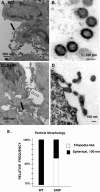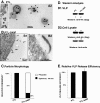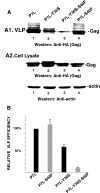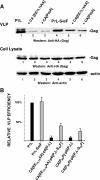The S40 residue in HIV-1 Gag p6 impacts local and distal budding determinants, revealing additional late domain activities
- PMID: 24257210
- PMCID: PMC3907034
- DOI: 10.1186/1742-4690-10-143
The S40 residue in HIV-1 Gag p6 impacts local and distal budding determinants, revealing additional late domain activities
Abstract
Background: HIV-1 budding is directed primarily by two motifs in Gag p6 designated as late domain-1 and -2 that recruit ESCRT machinery by binding Tsg101 and Alix, respectively, and by poorly characterized determinants in the capsid (CA) domain. Here, we report that a conserved Gag p6 residue, S40, impacts budding mediated by all of these determinants.
Results: Whereas budding normally results in formation of single spherical particles ~100 nm in diameter and containing a characteristic electron-dense conical core, the substitution of Phe for S40, a change that does not alter the amino acids encoded in the overlapping pol reading frame, resulted in defective CA-SP1 cleavage, formation of strings of tethered particles or filopodia-like membrane protrusions containing Gag, and diminished infectious particle formation. The S40F-mediated release defects were exacerbated when the viral-encoded protease (PR) was inactivated or when L domain-1 function was disrupted or when budding was almost completely obliterated by the disruption of both L domain-1 and -2. S40F mutation also resulted in stronger Gag-Alix interaction, as detected by yeast 2-hybrid assay. Reducing Alix binding by mutational disruption of contact residues restored single particle release, implicating the perturbed Gag-Alix interaction in the aberrant budding events. Interestingly, introduction of S40F partially rescued the negative effects on budding of CA NTD mutations EE75,76AA and P99A, which both prevent membrane curvature and therefore block budding at an early stage.
Conclusions: The results indicate that the S40 residue is a novel determinant of HIV-1 egress that is most likely involved in regulation of a critical assembly event required for budding in the Tsg101-, Alix-, Nedd4- and CA N-terminal domain affected pathways.
Figures








Similar articles
-
The ESCRT-associated protein Alix recruits the ubiquitin ligase Nedd4-1 to facilitate HIV-1 release through the LYPXnL L domain motif.J Virol. 2010 Aug;84(16):8181-92. doi: 10.1128/JVI.00634-10. Epub 2010 Jun 2. J Virol. 2010. PMID: 20519395 Free PMC article.
-
Ubiquitin conjugation to Gag is essential for ESCRT-mediated HIV-1 budding.Retrovirology. 2013 Jul 29;10:79. doi: 10.1186/1742-4690-10-79. Retrovirology. 2013. PMID: 23895345 Free PMC article.
-
Basic residues in the nucleocapsid domain of Gag are critical for late events of HIV-1 budding.J Virol. 2011 Mar;85(5):2304-15. doi: 10.1128/JVI.01562-10. Epub 2010 Dec 15. J Virol. 2011. PMID: 21159863 Free PMC article.
-
Wrapping up the bad news: HIV assembly and release.Retrovirology. 2013 Jan 10;10:5. doi: 10.1186/1742-4690-10-5. Retrovirology. 2013. PMID: 23305486 Free PMC article. Review.
-
Novel Tsg101 Binding Partners Regulate Viral L Domain Trafficking.Viruses. 2021 Jun 15;13(6):1147. doi: 10.3390/v13061147. Viruses. 2021. PMID: 34203832 Free PMC article. Review.
Cited by
-
Re-visiting the functional Relevance of the highly conserved Serine 40 Residue within HIV-1 p6(Gag).Retrovirology. 2014 Dec 19;11:114. doi: 10.1186/s12977-014-0114-8. Retrovirology. 2014. PMID: 25524645 Free PMC article.
-
Tsg101 chaperone function revealed by HIV-1 assembly inhibitors.Nat Commun. 2017 Nov 9;8(1):1391. doi: 10.1038/s41467-017-01426-2. Nat Commun. 2017. PMID: 29123089 Free PMC article.
-
Analysis of HIV-1 Gag protein interactions via biotin ligase tagging.J Virol. 2015 Apr;89(7):3988-4001. doi: 10.1128/JVI.03584-14. Epub 2015 Jan 28. J Virol. 2015. PMID: 25631074 Free PMC article.
-
Targeting HIV-1 Protease Autoprocessing for High-throughput Drug Discovery and Drug Resistance Assessment.Sci Rep. 2019 Jan 22;9(1):301. doi: 10.1038/s41598-018-36730-4. Sci Rep. 2019. PMID: 30670786 Free PMC article.
-
Tsg101 regulates PI(4,5)P2/Ca(2+) signaling for HIV-1 Gag assembly.Front Microbiol. 2014 May 20;5:234. doi: 10.3389/fmicb.2014.00234. eCollection 2014. Front Microbiol. 2014. PMID: 24904548 Free PMC article.
References
-
- Gottlinger HG. The HIV-1 assembly machinery. AIDS. 2001;10(Suppl 5):S13–20. - PubMed
-
- Garrus JE, Von Schwedler UK, Pornillos OW, Morham SG, Zavitz KH, Wang HE, Wettstein DA, Stray KM, Cote M, Rich RL, Myszka DG, Sundquist WI. Tsg101 and the vacuolar protein sorting pathway are essential for HIV-1 budding. Cell Dev Biol. 2001;10:55–65. - PubMed
Publication types
MeSH terms
Substances
Grants and funding
LinkOut - more resources
Full Text Sources
Other Literature Sources
Research Materials
Miscellaneous

